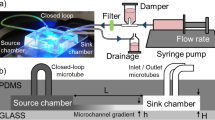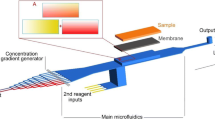Abstract
This paper describes a simple method of generating concentration gradients with linear and parabolic profiles by using a Christmas tree-shaped microfluidic network. The microfluidic gradient generator consists of two parts: a Christmas tree-shaped network for gradient generation and a broad microchannel for detection. A two-dimensional model was built to analyze the flow field and the mass transfer in the microfluidic network. The simulating results show that a series of linear and parabolic gradient profiles were generated via adjusting relative flow rate ratios of the two source solutions (RL2 ≥0.995 and RP2 ≥0.999), which could match well with the experimental results (RL2 ≥0.987 and RP2 ≥0.996). The proposed method is promising for the generation of linear and parabolic concentration gradient profiles, with the potential in chemical and biological applications such as combinatorial chemistry synthesis, stem cell differentiation or cytotoxicity assays.
Similar content being viewed by others
References
Dekker L, Segal A. Perspectives: signal transduction. Signals to move cells[J]. Science, 2000, 287(5455): 982–985.
Parent C A, Devreotes P N. A cell’s sense of direction[J]. Science, 1999, 284(5415): 765–770.
Weiner O D, Servant G, Welch M D, et al. Spatial control of actin polymerization during neutrophil chemotaxis[J]. Nature Cell Biology, 1999, 1(2): 75–81.
Walker G M, Sai J, Richmond A, et al. Effects of flow and diffusion on chemotaxis studies in a microfabricated gradient generator[J]. Lab on a Chip, 2005, 5(6): 611–618.
Cheng B, Wang S, Chen Y, et al. A combined negative and positive enrichment assay for cancer cells isolation and purification[ J]. Technology in Cancer Research & Treatment, 2016, 15(1): 69–76.
Poulsen C R, Culbertson C T, Jacobson S C, et al. Static and dynamic acute cytotoxicity assays on microfluidic devices[J]. Analytical Chemistry, 2005, 77(2): 667–672.
Bang H, Lim S, Lee Y, et al. Serial dilution microchip for cytotoxicity test[J]. Journal of Micromechanics & Microengineering, 2004, 14(8): 1165–1170.
Walker G M, Monteiro-Riviere N, Rouse J, et al. A linear dilution microfluidic device for cytotoxicity assays[J]. Lab on a Chip, 2007, 7(2): 226–232.
Ye N, Qin J, Shi W, et al. Cell-based high content screening using an integrated microfluidic device[J]. Lab on a Chip, 2007, 7(12): 1696–1704.
Puttaraksa N, Whitlow H J, Napari M, et al. Development of a microfluidic design for an automatic lab-on-chip operation[ J]. Microfluid Nanofluid, 2016, 20(10): 142–152.
Boyden S. Chemotactic effect of antibody and antigen[J]. Journal of Experimental Medicine, 1962, 115: 453–466.
Zicha D, Dunn G A, Brown A F. A new direct-viewing chemotaxis chamber[J]. Journal of Cell Science, 1991, 99(4): 769–775.
Song H J, Poo M M. Signal transduction underlying growth cone guidance by diffusible factors[J]. Current Opinion Neurobiology, 1999, 9(3): 355–363.
Mao H, Cremer P S, Manson M D. A sensitive, versatile microfluidic assay for bacterial chemotaxis[J]. Proceedings of the National Academy of Sciences of the United States of America, 2003, 100(9): 5449–5454.
Walker G M, Ozers M S, Beebe D J. Cell infection within a microfluidic device using virus gradients[J]. Sensors & Actuators B Chemical, 2004, 98(2): 347–355.
Ketterer S, Hovermann D, Guebeli R J, et al. Transcription factor sensor system for parallel quantification of metabolites on-chip [J]. Analytical Chemistry, 2014, 86(24): 12152–12158.
Wang W, Cui H, Zhang P, et al. Efficient capture of cancer cells by their replicated surfaces reveals multiscale topographic interactions coupled with molecular recognition[J]. ACS Applied Materials & Interfaces, 2017, 9(12): 10537–10543.
Zhou H, Yao S. A facile on-demand droplet microfluidic system for lab-on-a-chip applications[J]. Microfluid Nanofluid, 2013, 16(4): 667–675.
Jeon N L, Dertinger S K W, Chiu D T, et al. Generation of solution and surface gradients using microfluidic systems[J]. Langmuir, 2000, 16(22): 8311–8316.
Dertinger S K W, Chiu D T, Jeon N L, et al. Generation of gradients having complex shapes using microfluidic networks[ J]. Analytical Chemistry, 2001, 73(6): 1240–1246.
Irimia D, Geba D A, Toner M. Universal microfluidic gradient generator [J]. Analytical Chemistry, 2006, 78(10): 3472–3477.
Yamada M, Hirano T, Yasuda M, et al. A microfluidic flow distributor generating stepwise concentrations for highthroughput biochemical processing [J]. Lab on a Chip, 2006, 6(2): 179–184.
Lee K, Kim C, Ahn B, et al. Generalized serial dilution module for monotonic and arbitrary microfluidic gradient generators [J]. Lab on a Chip, 2009, 9(5): 709–717.
Kim C, Lee K, Kim J H, et al. A serial dilution microfluidic device using a ladder network generating logarithmic or linear concentrations [J]. Lab on a Chip, 2008, 8(3): 473–479.
Liu W, Lin J M. Online monitoring of Lactate Efflux by multi-channel microfluidic chip-mass spectrometry for rapid Drug Evaluation[J]. ACS Sensors, 2016, 1(4):344–347.
Gleichmann N, Malsch D, Horbert P, et al. Toward microfluidic design automation: A new system simulation toolkit for the in silico evaluation of droplet-based lab-on-a-chip systems[J]. Microfluid Nanofluid, 2014, 18(5): 1095–1105.
Li Y, Li L, Liu Z, et al. A microfluidic chip of multiple-channel array with various oxygen tensions for drug screening [J]. Microfluid Nanofluid, 2016, 20(7): 1–9.
Duffy D C, McDonald J C, Schueller O J A, et al. Rapid prototyping of microfluidic systems in poly(dimethylsiloxane) [J]. Analytical Chemistry, 1998, 70(23): 4974–4984.
Glasgow I, Aubry N. Run with the ball: Sony Entertainment Television changed the way cricket is sold in India, and went on to reinvent the relationship between branding, product placement and programming [J]. Lab on a Chip, 2003, 3(3): 114–120.
Author information
Authors and Affiliations
Corresponding author
Additional information
Foundation item: Supported by the National Natural Science Foundation of China(81372358, 81527801, 51303140, and 81602489), the Natural Science Foundation of Hubei Province (2014CFA029), the Colleges of Hubei Province Outstanding Youth Science and Technology Innovation Team (T201305), and the Applied Foundational Research Program of Wuhan Municipal Science and Technology Bureau (2015060101010056)
Biography: SHEN Qilong, male, Master candidate, research direction: design and preparation of microfluidic chip.
Rights and permissions
About this article
Cite this article
Shen, Q., Zhou, Q., Lu, Z. et al. Generation of Linear and Parabolic Concentration Gradients by Using a Christmas Tree-Shaped Microfluidic Network. Wuhan Univ. J. Nat. Sci. 23, 244–250 (2018). https://doi.org/10.1007/s11859-018-1317-y
Received:
Published:
Issue Date:
DOI: https://doi.org/10.1007/s11859-018-1317-y




